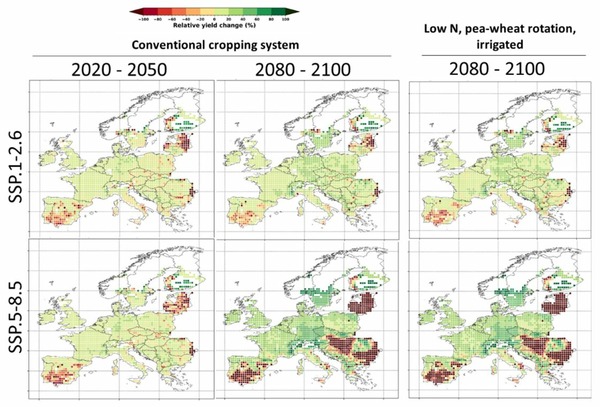Crop modelling activities in SolACE have demonstrated that for much of Europe the potential impact of climate change will be to increase yield potential of wheat and potatoes compared to current conditions. This is due to favourable changes in precipitation and temperature that allow the crops to take advantage of the increased atmospheric CO2 in future environments. So, in conditions of non-limiting stress, greater atmospheric CO2 will allow these crops (for example, wheat and potatoes) to fix more carbon and therefore improve resource use efficiencies, including light, water and nutrients.
Taking prevailing stresses into account
However, this is not likely to be the case where significant prevailing stresses exist. Therefore, it is important to note that the model used does not consider evolving biotic stresses, which are also likely to change with climate change and be particularly impactful on potato production. The importance of prevailing stress is seen when the climate predictions for wheat yield in Eastern and Southern Europe are considered. In these regions, we see the opposite of the North and West, and large declines in yield are predicted due to extreme temperatures and reduced availability of water at the start of the cropping season. One way to mitigate against this predicted decline in yield is to irrigate. When this is done, the projected extreme declines in wheat yield are reduced. The positive impact of irrigation on yield is also seen in the potato projections.
Interestingly, there is also a positive effect for wheat regions projected to have severe reductions in yield of reduced or conservation tillage systems. This is presumably a result of the greater availability of water with this treatment. However, with climate change and potentially increasing competition for watershed water use beyond agriculture, the ability to provide adequate irrigation water is at stake.
Importance of nitrogen
It is also clear from the projections that the maintained provision of nitrogen will be critical for mitigating the negative impacts of climate change in the south and east and for achieving the greatest yield increases in the north and west of Europe. While a slight reduction in N application was possible with limited negative impacts, total removal of N was detrimental in both the wheat and potato modelling scenarios. In addition, there were significant impacts of cultivar selection of wheat and potato and a choice of pre-crop. This suggests that there is some scope for matching the correct cultivars with the correct agronomy, but these effects were swamped by the substantial impacts of a lack of water and nitrogen.
Clearly, in order to mitigate against the worst impacts of climate change in the south and east of Europe and to take advantage of the potential yield gains in north and west Europe, we need to consider how we will find a sustainable source of both irrigation water and nitrogen. It will also be important to consider the potential impact of evolving biotic stress, which is not considered here.
Overall, the SolACE results from work package 1 highlights the importance and need for considering both the spatial and temporal variability in response of crop production to climate change and that adaptation needs to be considered on a seasonal and local scale, rather than at a regional, national or even continental scale.
Further information
- solace-eu.net: Policy brief on "Sustainable sources of irrigation water and nitrogen are critical for the adaptation of European crop production to climate change" (will be published shortly here)

 tap and then scroll down to the Add to Home Screen command.
tap and then scroll down to the Add to Home Screen command.
Disqus
Para poder utilizar la función de comentarios, debes registrarte en el proveedor externo «Disqus».
Cuando activas esta función, tu navegador establece una conexión directa con los servidores del proveedor externo. Nos gustaría señalar que, tras la activación, los datos se transmitirán al proveedor externo y éste podrá establecer cookies, que también podrán utilizarse con fines de análisis y marketing. Para más información, consulta nuestra política de privacidad.
Activar